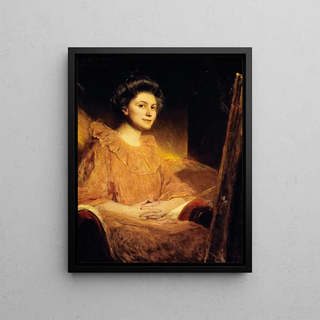Art print | Portrait of Angle Delasalle - Jean-Joseph Benjamin-Constant


View from behind

Frame (optional)
Jean-Joseph Benjamin-Constant's "Portrait of Angle Delasalle" is a work that commands attention through its elegance and psychological depth. Created at the end of the 19th century, this art print embodies not only the undeniable talent of the artist but also the spirit of an era in full transformation. The figure of Angle Delasalle, captured with remarkable finesse, seems to come to life under Benjamin-Constant's brush. Every stroke reveals a story, an emotion, immersing the viewer in a universe where beauty and mystery meet. This art print, through its composition and use of colors, evokes a rare intimacy while inviting us to explore the subtleties of the human soul.
Style and uniqueness of the work
Benjamin-Constant's style is distinguished by a realistic approach, blended with Impressionist influences, which gives his portraits unprecedented luminosity and depth. In the "Portrait of Angle Delasalle," warm tones and play of light create an enveloping atmosphere. The artist succeeds in capturing not only the physical features of his model but also his essence. The meticulous details of the clothing, the penetrating gaze, and the delicate posture of Delasalle testify to exceptional technical mastery. This art print does not merely depict an individual; it tells a story, that of a man and his era, while evoking universal feelings that still resonate today.
The artist and his influence
Jean-Joseph Benjamin-Constant, an emblematic figure of French academic painting, established himself as a master of portraiture at the turn of the 20th century. Trained at the École des Beaux-Arts in Paris, he was influenced by great masters such as Delacroix and Ingres. His work is characterized by a particular attention to detail and a capacity to capture the psychology of his subjects. Benjamin-Constant also played a crucial role in the evolution of painting during his time, integrating modern elements while respecting academic traditions. His contribution to art is undeniable, and his influence is felt across generations of artists who followed, demonstrating the enduring legacy of his artistic vision.

Matte finish

View from behind

Frame (optional)
Jean-Joseph Benjamin-Constant's "Portrait of Angle Delasalle" is a work that commands attention through its elegance and psychological depth. Created at the end of the 19th century, this art print embodies not only the undeniable talent of the artist but also the spirit of an era in full transformation. The figure of Angle Delasalle, captured with remarkable finesse, seems to come to life under Benjamin-Constant's brush. Every stroke reveals a story, an emotion, immersing the viewer in a universe where beauty and mystery meet. This art print, through its composition and use of colors, evokes a rare intimacy while inviting us to explore the subtleties of the human soul.
Style and uniqueness of the work
Benjamin-Constant's style is distinguished by a realistic approach, blended with Impressionist influences, which gives his portraits unprecedented luminosity and depth. In the "Portrait of Angle Delasalle," warm tones and play of light create an enveloping atmosphere. The artist succeeds in capturing not only the physical features of his model but also his essence. The meticulous details of the clothing, the penetrating gaze, and the delicate posture of Delasalle testify to exceptional technical mastery. This art print does not merely depict an individual; it tells a story, that of a man and his era, while evoking universal feelings that still resonate today.
The artist and his influence
Jean-Joseph Benjamin-Constant, an emblematic figure of French academic painting, established himself as a master of portraiture at the turn of the 20th century. Trained at the École des Beaux-Arts in Paris, he was influenced by great masters such as Delacroix and Ingres. His work is characterized by a particular attention to detail and a capacity to capture the psychology of his subjects. Benjamin-Constant also played a crucial role in the evolution of painting during his time, integrating modern elements while respecting academic traditions. His contribution to art is undeniable, and his influence is felt across generations of artists who followed, demonstrating the enduring legacy of his artistic vision.






